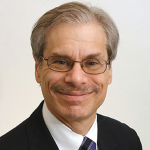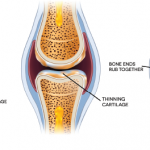Dr. Felson was awarded the inaugural Robert Dawson Evans Research Mentoring Award at BU in 2007.
Forging New Territories
Dr. Felson has consistently applied his multidisciplinary bent to exploring key questions in rheumatic diseases. In 1998, Dr. Dutta of the NIA recalls, he and Dr. Nevitt approached the institute with a concept for the Multicenter Osteoarthritis Study (MOST).4 “At that time,” she says, “there was a lot of discussion in the OA field about the discrepancy between radiographic changes in the knee and the symptomatology reported by patients. There was also limited availability of information on modifiable risk factors for the onset and progression of knee OA. The innovative aspect of the MOST project was that it sought to address key knowledge gaps in the OA field through the use of X-rays and MRIs, in a prospective longitudinal study design.” The NIA issued grant awards to the MOST study in 2001 and follow up of the MOST cohort is ongoing.
In the late 1990s, Dr. Felson saw an opportunity to expand investigations to Asia. Through his colleague Dr. Nevitt and other colleagues at UCSF, linkage with a Chinese investigator, Ling Xu, based at the Peking Union Medical College in Beijing, was established. The National Institute of Arthritis and Musculoskeletal and Skin Diseases (NIAMS) funded a study to compare knee, hip, and hand OA among Chinese to Caucasians in the Framingham study and the UCSF Study of Osteoporotic Fractures. (Listen to Dr. Felson discuss the study.)
Dr. Nevitt recalls the experience, which included six or seven trips to China, as an “amazing, fun, and challenging experience.” He says, “we had some great collaborators in China who already had experience doing this kind of study with osteoporosis. I think that David was really excited by this project: being able to address a question that he had posed in review articles many years before about distribution of OA in various countries and ethnic groups.”
Taking into account cultural nuances challenged the research team, says Dr. Nevitt, as they strived to develop and translate existing questionnaires that would have relevance in the Chinese population. All in all, says Dr. Nevitt, the Beijing study remains one of the highlights of his collaborations with Dr. Felson.5 (They are also co-investigators on the MOST [Multicenter Osteoarthritis Study].) “[The Beijing study] was a lot of fun, and David made it a wonderful experience,” he recalls.
A longstanding interest in meta-analysis has also been a key factor in Dr. Felson’s involvement with the ACR’s efforts to establish definitions of remission in RA for clinical trials. “I was impressed with the cancer world,” he says, “which seemed to have figured out how to standardize indicators. They have actual numbers of how many people with disease go into remission, and what treatments work. We didn’t have anything like that in rheumatology.” He helped to create an international committee of participants to establish a provisional definition of disease remission in RA to be used in clinical trials.6


